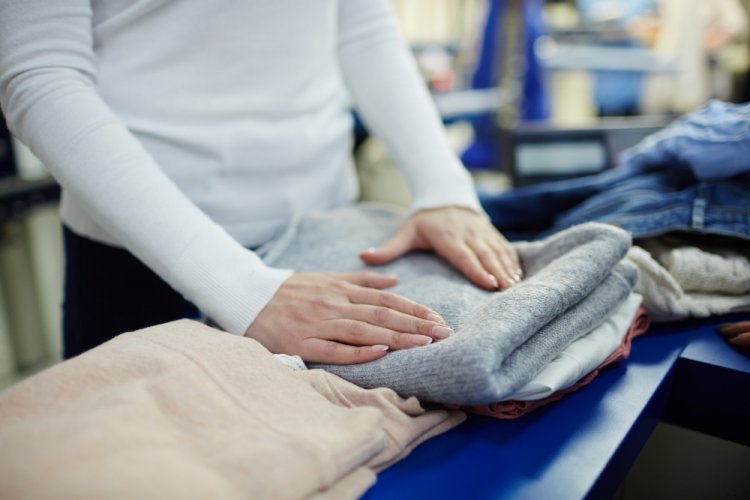Behind the Scenes: How Dry Cleaning Really Works
Discover the dry cleaning process, from stain removal to fabric care. Learn how professionals clean delicate clothes without water.

Dry cleaning is a fascinating process that keeps clothes fresh and clean without using water. While many people rely on dry cleaning for their delicate fabrics, suits, dresses, and coats, few understand what happens behind the scenes.
Unlike regular washing, which uses water and detergent, dry cleaning uses special solvents to clean clothes without shrinking or damaging the fabric. This method is particularly useful for materials like silk, wool, and suede, which can lose their shape or texture when washed in water.
In this blog, we’ll take a behind-the-scenes look at how dry cleaning really works, from drop-off to final delivery.
1. Step One: Clothing Inspection and Tagging
The dry cleaning process starts when you drop off your clothes at a dry cleaner. Each item is carefully inspected for:
✔️ Stains
✔️ Fabric type
✔️ Damage (like missing buttons or loose seams)
Once the inspection is complete, the clothes are tagged with identification labels. This ensures that each garment is returned to the right customer after cleaning.
2. Step Two: Pre-Treatment of Stains
Before the cleaning begins, stains are treated using specialized stain removers. The type of stain remover used depends on the stain’s origin:
✅ Oil-based stains (grease, makeup) – Removed with solvents.
✅ Water-based stains (coffee, wine) – Treated with steam or mild detergent.
✅ Ink or dye stains – Handled with chemical spot removers.
Dry cleaners use their expertise to remove stains without damaging delicate fabrics. This pre-treatment step ensures the stains don’t set permanently during cleaning.
3. Step Three: The Dry Cleaning Process
Now comes the main step—dry cleaning itself. Unlike traditional washing, dry cleaning uses a liquid solvent instead of water. The most commonly used solvents include:
✔️ Perchloroethylene (PERC) – A powerful cleaner for tough stains.
✔️ Hydrocarbon-based solvents – A milder alternative for delicate fabrics.
✔️ Green solvents – Eco-friendly options used by some dry cleaners.
The clothes are placed in a dry cleaning machine, which looks like a large washing machine. The machine:
???? Rotates the clothes gently
???? Releases the solvent to dissolve dirt and oil
???? Filters out impurities to keep the solvent clean
This process removes stains, dirt, and odors without using water, preserving the shape and texture of the fabric.
4. Step Four: Post-Cleaning Inspection and Spot Treatment
Once the clothes are dry-cleaned, they are inspected again for any remaining stains or missed spots. If needed, additional stain treatment is applied, followed by light steaming or brushing to restore the fabric’s smooth finish.
5. Step Five: Pressing and Finishing
After cleaning, garments go through pressing and steaming to remove wrinkles. Depending on the fabric, different techniques are used:
???? Steam pressing – For delicate fabrics like silk.
???? Heat pressing – For crisp, structured fabrics like suits.
???? Hand ironing – For intricate designs or beaded clothing.
Some clothes also go through reshaping and minor repairs, such as sewing loose buttons or fixing seams, to restore them to their original condition.
6. Step Six: Packaging and Final Touches
Once the garments are cleaned, pressed, and inspected, they are carefully packaged to prevent wrinkles. Dry cleaners use:
✅ Plastic covers – To protect clothes from dust.
✅ Hangers – To maintain shape.
✅ Tissue paper – For delicate garments.
Each item is tagged again to ensure it goes back to the right customer. At this point, the clothes are fresh, clean, and ready for pickup or delivery.
Why Dry Cleaning is Essential for Delicate Fabrics
Many fabrics can’t handle water without losing their quality. Here’s why dry cleaning is the best option for them:
✔️ Silk – Prevents water stains and fabric weakening.
✔️ Wool & Cashmere – Maintains softness without shrinking.
✔️ Suede & Leather – Cleans without cracking or stiffening.
✔️ Beaded & Embroidered Clothes – Protects delicate decorations.
Regular dry cleaning extends the lifespan of these materials, keeping them looking new for longer.
Benefits of Professional Dry Cleaning
If you’re wondering why dry cleaning is necessary, here are some key advantages:
✅ Deep Cleaning Without Damage – No water means no shrinking or fading.
✅ Effective Stain Removal – Special solvents remove tough stains.
✅ Fabric Protection – Clothes maintain their shape and texture.
✅ Odor Elimination – Removes sweat and smoke smells.
✅ Convenience – Saves time and effort compared to hand washing.
For those with busy schedules, using online dry cleaning services in Karachi offers even more convenience, as they pick up and deliver clothes to your doorstep.
Conclusion
Dry cleaning is a complex but highly effective process that goes beyond regular washing. By using advanced solvents and expert techniques, professional dry cleaners remove stains, protect fabrics, and extend the life of your clothes.
Whether you need to clean a delicate silk dress, a wool coat, or a suit, dry cleaning ensures your clothes remain fresh, clean, and in perfect condition. For hassle-free and efficient dry cleaning, try online laundry dry cleaning services near you in Karachi today!
What's Your Reaction?












